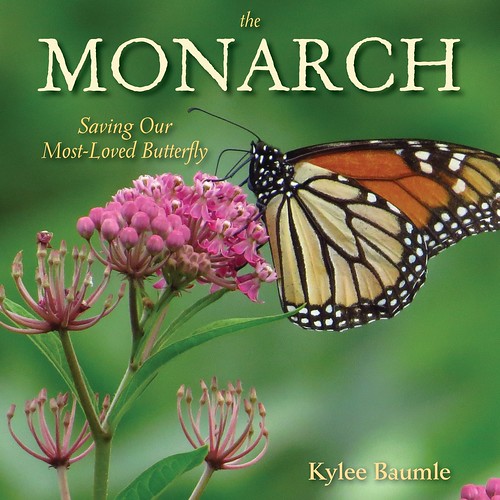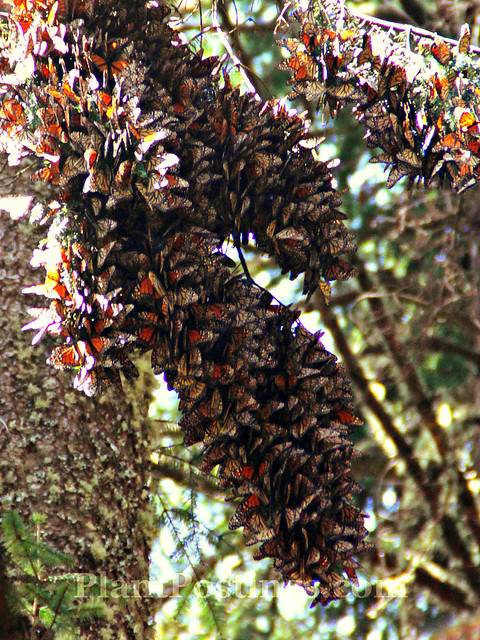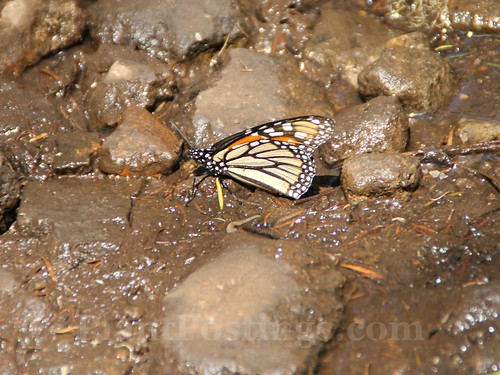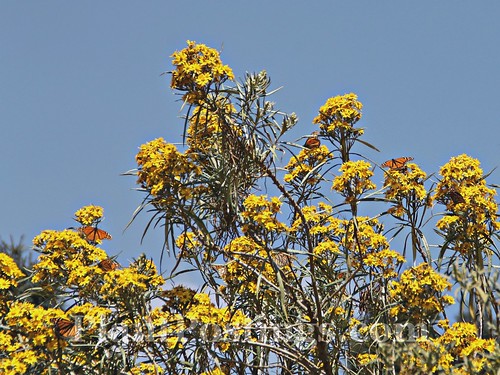 |
| Kylee and me, posing just before we reached our first visit to a Monarch butterfly sanctuary. |
If you guessed the location of my last post was Mexico, you were correct! My friend, Kylee Baumle, hosted our trip to the Monarch butterfly sanctuaries in Michoacan, Mexico, about 75 miles west of Mexico City. If you're unfamiliar with the Monarch migration, check out this brief description from Annenberg Learner's Journey North.

Better yet, consider ordering Kylee's new book: The Monarch: Saving Our Most-Loved Butterfly, available in April. The book will include information about Monarchs, amazing photographs, and tips on how to help save the Monarch migration, which has been described as facing a "quasi-extinction."
I felt so fortunate to experience the trip.

The Monarch migration is a big part of the local identity and culture in the Mexican state of Michoacan. There were many highlights of our trip, but I'll start with a few photos from the butterfly sanctuaries--our primary purpose.

The two sanctuaries we visited were El Rosario and Sierra Chincua. One day was sunny and warm, and the butterflies were actively flying all around us. The other day was cloudy and cooler, so we were able to see big clusters of Monarchs huddling together to stay warm.

On both days, we took advantage of horseback rides partway up the mountain. That was fun!

It was a joy to see Monarch butterflies in early March--flying free across the bright blue sky. It was also interesting to see their winter habitat.

Every year, they migrate to these Oyamel Fir (Abies religiosa) forests. Science can explain part of the story, but mysteries still remain about much of the Monarch migration story.
This next series of photos shows clusters of Monarchs--from a distance and then at closer range. It's hard to explain the feeling of seeing this great number of butterflies in one small area. The clusters look like leaves growing on the trees.





The butterflies we saw appeared to be in good shape--especially considering most of them had migrated from northern North America months ago.

Some Monarchs were puddling--consuming water and minerals from the mud.


Others were nectaring on local wildflowers, including ironweeds, ragworts, salvias, bonesets, and many others.


Still others were sunning. Notice the spent wing on the rock: While some Monarchs mate and lay eggs as they travel north along the spring migration route, as many as 50% to 75% die in the Oyamel forests, depending on the conditions from year to year. The live Monarchs completely migrate out of Mexico every spring, and their descendants migrate back in the fall.

In March 2016, a late freezing winter storm hit the sanctuaries, killing millions of Monarchs and damaging many of the forest trees.

This year, the weather has been a little more forgiving, but there are still many dead butterflies on the forest floor. Some people who raise Monarchs tag them for tracking and research. Here you see Kylee searching for tags that can provide valuable data, including information on where the butterflies originated.


It still seems like a dream. Tourism is important to supporting the migration, so if you're in good shape and you have a chance to make the trip in the future, go for it! For more information on the Monarch migration, visit Monarch Watch or Journey North.
Here's a quick video, showing what it was like to have butterflies flying all around us and above us:
An incredible amount of butterflies. Yet I am seen anything like it, and certainly do not see, because in Mexico I have very far. I did not see even that such a thing exists. Regards.
ReplyDeleteYes, it is incredible. So difficult to describe, but one of those amazing earth happenings--among many that happen on this wonderful planet. I'm so glad I was able to see it. :)
DeleteAmazing! Thank you for sharing!
ReplyDeleteIt was wonderful. You are welcome. :)
DeleteWhat fun you must have had!
ReplyDeleteYes, indeed. It was a fun trip and it was an exciting trip! Much more fun and exciting (yet comforting) than I could have imagined.
DeleteHello, it is amazing to see so many monarchs. I am so happy they are doing so well there. Beautiful sight to see and lovely photos.
ReplyDeleteEnjoy your day and the week ahead!
Hi Eileen: The numbers are down from what they were years ago, and there's a danger that the migration might end with loss of habitat and Milkweed in the north and loss of habitat in the south. I hope that won't happen. It was fascinating to see so many of them in one small area of Mexico.
DeleteAbsolutely amazing . . .
ReplyDeleteWhat an experience it must be!
Yes, it was incredible! So wonderful to see the Monarch butterflies in their winter habitat!
DeleteI can only imagine what an incredible sight this must have been. I was wondering if you saw any with tags on them?? Are they ever recovered?
ReplyDeleteYes, it was amazing! We didn't find any tags, but apparently a large number of them have been found this year--more than most years. I'm not sure how many they find each year, but here's a list of tags recovered in 2016:
Delete2015 season recoveries. This page has fascinating stories about tagged butterflies:
www.learner.org/jnorth/tm/monarch/TagRecoveryStories.html.
That is amazing!! What a wonderful trip! Thank you for sharing the photos of such a wonderful place. I would love to go sometime.
ReplyDeleteYes, it was wonderful. You are welcome. If you have a chance, you must go! It's an incredible phenomenon.
DeleteHi Beth, that is a great post! It must have been an amazing experience to go to these Mexican Monarch Butterfly sanctuaries and really see the butterflies in their natural winter habitats. The photos of the Monarchs hanging by the thousands on one branch of a tree are totally stunning.
ReplyDeleteI also enjoyed watching the video to get a better feel for the "real experience".
Warm regards,
Christina
Thanks, Christina. Part of the joy of the trip was simply taking it all in. I tried to spend some of the time observing quietly. It was really neat to experience it with other people. We even made some new friends on the same pilgrimage.
DeleteEven knowing about this it is still amazing to see the pictures. When you showed the image last week it almost looked like some kind of art piece. What a memorable experience for you!
ReplyDeleteYes, it was fantastic. Yes, it's hard to believe they cluster together in large stacked colonies, but they truly do. It's fascinating to see them fly out of the clusters, too--during the middle of the day when the sun comes out.
DeleteWhat an awesome experience. Great post! I'd no idea that the mortality rate was so high.
ReplyDeleteIt was great! I knew many of them die in Mexico, but I didn't realize the range and extent until our guide talked about it, and then I did some research. There's a certain degree of mortality that is normal, but it increases with bad storms and cold weather.
DeleteOh, what an experience. The photos of the butterfly clusters on the trees are just incredible.
ReplyDeleteYes, I was thrilled to be able to travel there--especially with someone as knowledgeable as Kylee. The clusters were hard to believe, but then it was clear what they were when we got closer.
DeleteWow, just wow! The trip of a lifetime! What a magical experience. Did they say anything about how much area was covered by Monarchs this year versus last year?
ReplyDeleteYeah, it was pretty awesome. And the price was reasonable (the experience was priceless!). The area covered is lower this year, but not as bad as the worst years. Here's a report on the numbers through recent years:
Deletehttp://monarchwatch.org/blog/2017/02/11/monarch-population-status-30/.
Looks like you had a wonderful trip! I would love to experience that one day, absolutely incredible :)
ReplyDeleteIt was fun, educational, and awe-inspiring! I highly recommend doing it if you have a chance. :)
DeleteI'm sure you were beyond words when you first saw the multitude of butterflies - a jaw dropping experience. How incredibly sad that so many do not make it past the forest.
ReplyDeleteYes, I think the most dramatic moment was when we got close to the colonies at El Rosario on the sunnier day. The butterflies were very active, and they were swooping in through the valleys in great quantities. A certain degree of mortality is normal. But it's very sad when a bad storm or a freezing event happens and large numbers die. It would be sad if this magical migration came to an end.
DeleteWow! (overused but most fitting) I've seen monarchs gathered in eucalyptus trees near Morro Bay, CA, but never like this!!
ReplyDeleteHollis: I would love to see the colonies in California, too. Yeah, there was a certain point when we were seeing quite a few on flowers and trees and it seemed similar to what I see around here in the fall ... and then the closer we got to the colonies, the more they were swooping in from every direction in great quantities. That's when the enormity of it really hit me. :)
DeleteWow! What an experience, it really is the trip of a lifetime! I can only imagine what it's like to see those beauties in their winter habitat. Thank you, Beth for sharing this.
ReplyDeleteHi Tina: You're welcome. Yes, it was incredible! If you ever have the chance to make the trip, you'd love it. Especially because you live relatively close and you have a pollinator-friendly garden. :)
DeleteIt is all of awesome, incredible, amazing, beautiful and a bit scary! But i am envious of your opportunity.
ReplyDeleteAndrea: Yes, it was a unique experience. I kind of knew what to expect, and yet the enormity of it really took my breath away. So many Monarch butterflies in such a small area!
DeleteWhat an incredible trip. I never knew there were such sanctuaries. I can hardly imagine what it must have been like to in the midst of all those threatened creatures. And thank you for taking all those great photographs to share. I will look for Kylee's book for sure.
ReplyDeleteThanks, Pat. Yes, it was a wonderful trip--one I'll remember forever. I'm sure Kylee's book will be amazing! :)
DeleteAmazing. Thank you for sharing! I hope to see such a sight myself one day... You have given me inspiration to try to go soon!!
ReplyDeleteAaron: You would absolutely love this trip! I think Kylee might be planning another one soon. And there are many groups that plan these trips. We booked through S&S Tours, and they were great!
DeleteSuch a fantastic place with so many photo ops!
ReplyDeleteIt was amazing. It will be a special memory forever!
DeleteOh wow...oh wow...oh wow...I would love to visit...it is a magical place and I am glad you got to go and to share it..wow....Michelle
ReplyDeleteYes, it is! If you ever have a chance to go, you would love it. I'm still processing it, and raising and supporting Monarch caterpillars and butterflies will have special meaning this year.
DeleteThis is such a wonderful and informative post! Thank you for sharing your experience at this amazing place. I have visited a couple of butterfly sanctuaries, but not nearly as extensive as this one. I often worry about the future of the Monarchs and these sanctuaries are such a wonderful cause.
ReplyDeleteThanks, Lee. It was an unforgettable experience. I worry about the Monarchs, too. I hope future generations will be able to witness the Monarch migration.
DeleteWhat a wonderful trip, I'm finding it hard to get my heard around putting tags on butterflies, but I suppose Monarchs are quite big. They look fragile but even though so many die I guess they are tougher than they look. Thanks for this enjoyable fascinating post, Beth. And I enjoyed exploring the Youtube clips.
ReplyDeleteHi Sue: Yes, it was so much fun and such a great opportunity! I haven't tagged the Monarchs that I've released, but I'm told it's perfectly safe and it helps immensely with research. Apparently, a certain percentage of mortality in the Mexico sanctuaries is "normal," but the more we can help them the better.
DeleteI am also wondering how you would tag a butterfly?
DeleteWhat an amazing experience~! the clusters of monarchs are breathtaking. It must be a little heart breaking to see so many dead monarchs litter the ground. I know it makes me sad when I see just one in my garden.
ReplyDeleteHi Karin: Yes, it was awesome! I don't remember seeing many dead ones here in the north, but there were many in the sanctuaries. I expected that, so it wasn't overwhelming. I tried to think of it as a normal part of the journey. Even the ones that die in the sanctuaries help keep their fellow butterflies that survive warm and healthy. But it is still a little sad.
DeleteAMAZING!!
ReplyDeleteThank you for sharing.
I do wonder about the tags. Are they working out well?
I will look for the book!
Thank you for sharing,
Carla
Hi Carla: Yes, it's a priceless opportunity. If you ever have a chance to go--take it! Regarding the tags: Yes, my understanding is that they help immensely with the research, which ultimately helps to save the Monarch migration.
DeleteThere are no words to describe this other than Wow! and Amazing! The sight of all those clusters on the trees must have taken your breath away. What a fantastic experience, one of those "bucket list" trips that I'm sure you will never forget, Beth.
ReplyDeleteYes, it's hard to describe. Such an amazing and unique natural wonder. The Journey North site is showing that the Monarchs are on the move. Before we know it, their descendants will be in our gardens!
DeleteWe have just gotten our Monarch Sanctuary Certification from NABA. We live on the Texas Gulf Coast and have already counted 12 Monarch caterpillars on our milkweed. My husband has expanded our butterfly garden each year and this year he planted 100 additional milkweeds. We are also trying Blue Mist flowers for the first time. Loved your photos.
ReplyDeleteThat's so exciting, Florence! Thanks for your kind comments. One thing that's so special about a trip to the overwintering sites is a greater appreciation for the journey the butterflies make, and the habitat they inhabit during the winter. Enjoy butterfly season!
DeleteWow, Beth! Your photos and video are amazing! You could make an awesome calendar with your photos. What a blessing to be able to experience this!
ReplyDeleteThank you, Sue! It was the trip of a lifetime. You would love it! :)
Delete